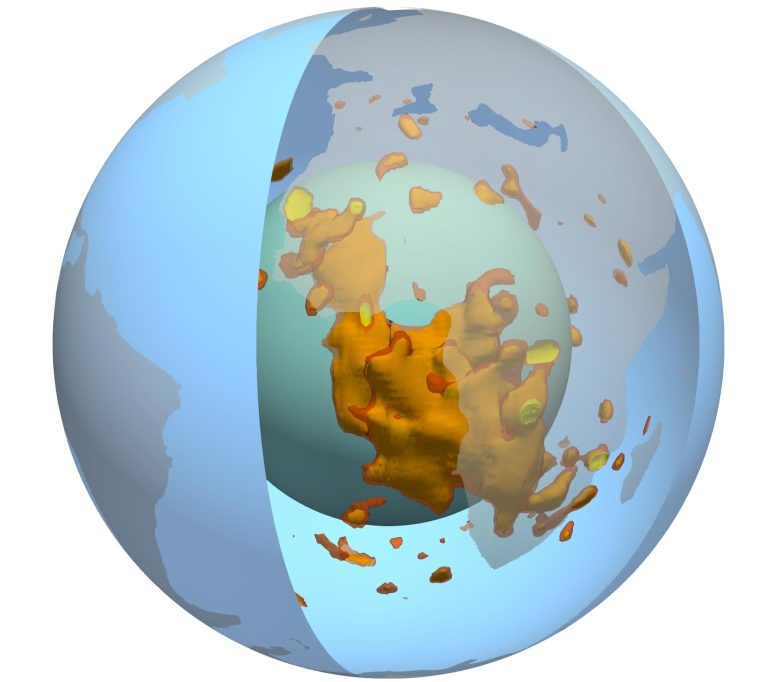
Τρισδιάστατη άποψη του σημείου στον μανδύα της Γης κάτω από την Αφρική, που εμφανίζεται με κόκκινο, κίτρινο και πορτοκαλί χρώμα. Το κυανό αντιπροσωπεύει το κύριο όριο του μανδύα, το μπλε δείχνει την επιφάνεια και το διαφανές γκρι τις ηπείρους. Πίστωση: Mingming Li / ASU
Η γη είναι στρωμένη σαν κρεμμύδι, με λεπτή εξωτερική κρούστα, παχύ, κολλώδες μανδύα, υγρό εξωτερικό πυρήνα και συμπαγή εσωτερικό πυρήνα. Μέσα στον μανδύα, υπάρχουν δύο ογκώδεις σημειακές δομές, περίπου και στις δύο πλευρές του πλανήτη. Τα σημεία, που επίσημα αναφέρονται ως Μεγάλες Επαρχίες Χαμηλής Ταχύτητας (LLSVPs), έχουν το μέγεθος μιας ηπείρου και 100 φορές ψηλότερα από το Έβερεστ. Το ένα βρίσκεται κάτω από την αφρικανική ήπειρο, το άλλο κάτω από τον Ειρηνικό Ωκεανό.
Χρησιμοποιώντας όργανα που μετρούν τα σεισμικά κύματα, οι επιστήμονες γνωρίζουν ότι αυτές οι δύο σταγόνες έχουν πολύπλοκα σχήματα και δομές, αλλά παρά τα αξιοσημείωτα χαρακτηριστικά τους, λίγα είναι γνωστά για το γιατί υπάρχουν οι σταγόνες ή τι οδήγησε στα παράξενα σχήματά τους.
Οι επιστήμονες της ASU Qian Yuan και Mingming Li του Κολλεγίου Γης και Διαστημικής Εξερεύνησης ξεκίνησαν να μάθουν περισσότερα για αυτά τα δύο σημεία χρησιμοποιώντας γεωδυναμική μοντελοποίηση και αναλύσεις δημοσιευμένων σεισμικών μελετών. Μέσω της έρευνάς τους, μπόρεσαν να προσδιορίσουν το μέγιστο ύψος που φτάνουν οι σταγόνες και πώς το μέγεθος και η πυκνότητα των σταγόνων, καθώς και το περιβάλλον ιξώδες στον μανδύα, μπορούν να ελέγξουν το ύψος τους. Η έρευνά τους δημοσιεύτηκε πρόσφατα στο
The results of their seismic analysis led to a surprising discovery that the blob under the African continent is about 621 miles (1,000 km) higher than the blob under the Pacific Ocean. According to Yuan and Li, the best explanation for the vast height difference between the two is that the blob under the African continent is less dense (and therefore less stable) than the one under the Pacific Ocean.
To conduct their research, Yuan and Li designed and ran hundreds of mantle convection models simulations. They exhaustively tested the effects of key factors that may affect the height of the blobs, including the volume of the blobs and the contrasts of density and viscosity of the blobs compared with their surroundings. They found that to explain the large differences of height between the two blobs, the one under the African continent must be of a lower density than that of the blob under the Pacific Ocean, indicating that the two may have different composition and evolution.
“Our calculations found that the initial volume of the blobs does not affect their height,” lead author Yuan said. “The height of the blobs is mostly controlled by how dense they are and the viscosity of the surrounding mantle.”
“The Africa LLVP may have been rising in recent geological time,” co-author Li added. “This may explain the elevating surface topography and intense volcanism in eastern Africa.”
These findings may fundamentally change the way scientists think about the deep mantle processes and how they can affect the surface of the Earth. The unstable nature of the blob under the African continent, for example, may be related to continental changes in topography, gravity, surface volcanism and plate motion.
“Our combination of the analysis of seismic results and the geodynamic modeling provides new insights on the nature of the Earth’s largest structures in the deep interior and their interaction with the surrounding mantle,” Yuan said. “This work has far-reaching implications for scientists trying to understand the present-day status and the evolution of the deep mantle structure, and the nature of mantle convection.”
Reference: “Instability of the African large low-shear-wave-velocity province due to its low intrinsic density” by Qian Yuan and Mingming Li, 10 March 2022, Nature Geoscience.
DOI: 10.1038/s41561-022-00908-3



